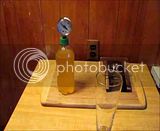RukusDM
Well-Known Member
Rukus, your PM box must be full.
Ferm temp low 60's, no exact number. Campden was only added 24 hours prior because it was raw and for all I know this lady accidentally ground up one of the stray cats in the cider press. Bottle conditioned is 72, almost exactly, kitchen counter temp.
Thought #1:
I didn't use a pressure gauge. I went by bubbles and foam in the glass when poured. 12 hours, "carbonated". It occurred to me just now, there is already alot of CO2 dissolved in the cider from fermentation... I just degassed another batch by gently swirling the carboy and this occurred to me. Because there was so much CO2 already in the liquid, a long wait for the bottle to carb wasn't necessary.
Thought #2:
It went from 1.056 to 1.020 in about 6 days. That equals about 6 gravity points a day, or 3 gravity points every 12 hours. My understanding, I've read somewhere, it's less than 1 gravity point that is necessary to carbonate a beer. Doing a quick calculation, a standard 5 oz of priming sugar in a 5 gallon batch of beer only bumps the gravity by 0.001.
Regarding Thought #1....Both Pimento, and myself saw a 5 Psi increase within a few hours of filling our Pressure Test bottles. I think this gives your idea allot of merit. The yeast certainly couldn't have done that as they were slightly dormant at the time of bottling. The only other explenation would be degassing of the cider filling the head space. Nice
Do you agree with this postulation?

























































